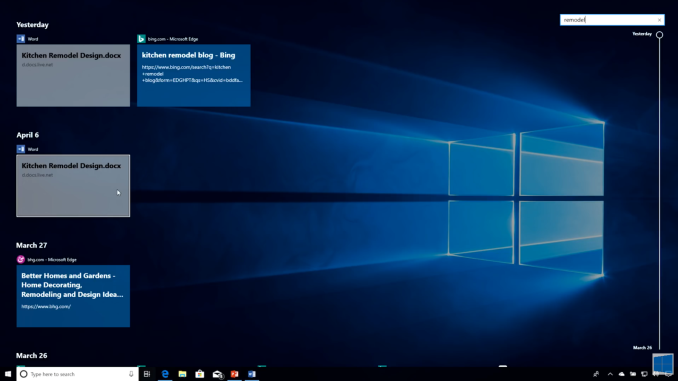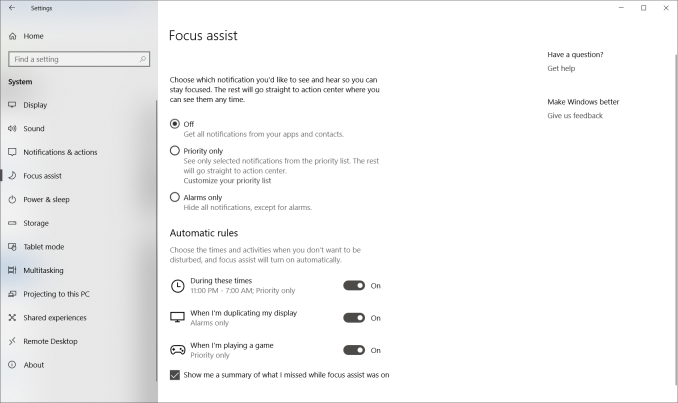The Windows 10 April Update (1803): The Littlest Big Update
by Brett Howse on May 25, 2018 8:00 AM EST- Posted in
- Software
- Operating Systems
- Windows
- Microsoft
- Windows 10
Timeline
Arguably the biggest feature new feature for Windows 10 is one aimed squarely at productivity. Timeline is part of the Task view feature that was previously in Windows 10, and accessed in the same way, either by clicking the icon on the task bar, or pressing Win + Tab. The idea of Timeline is to make it very easy to get back into a task you were doing previously or find some information you know you had open in a browser.
 Sorry for the poor screenshot but Timeline isn't working for me
Sorry for the poor screenshot but Timeline isn't working for me
By default, Timeline is only set to go back a single day, and apps will be sorted by hour. You can optionally enable it to go back 30 days as well, which seems like a more useful method to have as the default.
You can also adjust how Timeline works in the Privacy settings. When enabled, Timeline will sync activities from this PC, and also sync them to the cloud, so you can access documents and information across devices. But if you’d rather not have that data collected, you can disable the cloud sync, the local PC activity collection, or both.
Focus Assist
Another feature added with the April Update which focuses on keeping you focused is Focus Assist. After clamoring for notifications on the PC after seeing their benefit in mobile, it quickly became apparent that, while useful, notifications can also be a distraction.
In previous versions of Windows 10, Microsoft offers a Quiet Hours feature where you could set the PC to not provide notifications depending on the time, but with Focus Assist, that ability is expanded upon.
In addition to being able to schedule a time when notifications are muted, you can now change what level of notifications come through, with a custom priority list. You could in theory mute all notifications except those you want to see, which sounds fairly useful, or you could just set a time where you want to get some work done and only have alarms appear.
There’s also additional new automatic rules for notification action when duplicating a display, which will be very beneficial to avoid embarrassing notifications when using a projector, as well as when gaming.
Enabled by default is also a summary of notifications that were missed while focus assist was on, so if you were gaming, you’ll get a handy summary of everything that happened while you were having some fun, so you can get back to work.
This is of course still coupled with the notification settings where you can enable or disable notifications per-app.
Focus Assist is the kind of feature that Windows 10 needs. Notifications are great, but they can be distracting when you’re trying to get some work done. It would be great if Microsoft added some more settings here to allow you to create more automatic rules, such as when you have an app open, or additional time slots rather than just the single time you can enable it now.











161 Comments
View All Comments
nico_mach - Friday, May 25, 2018 - link
They pretty much did? These are the best, most useful implementations of Linux on Windows I've seen, and they're only lacking server versions.If you mean, why don't they ship linux? Well, they kind of do on Azure. There's no real reason to do so as a consumer facing OS, unless you're suggesting Windows EdgeOS? Which is very clearly crossing the line into why-bother territory.
PeachNCream - Tuesday, May 29, 2018 - link
There's no value in running something other than a *nix kernel at this point. If they want to keep costs low in the OS development department, then its probably as good a time as any to make the transition. The open source community and Microsoft could further mutually benefit from working together as would software compatibility and cross-platform functionality. All of that can be relatively hidden from the end user by the OS UI so aside from the one-time cost of conversion, a cost they could absorb into pushing out Windows 11 -- something that they'll eventually have to do anyway given predominant market forces, I think staying on their current course is a misstep and a missed opportunity for the computing industry in general and Microsoft in specific.ChristopherFortineux - Friday, June 8, 2018 - link
Because linux will never be fully supported for everyday use and software across the board. They can run the kernel within Windows already.Kvaern1 - Friday, May 25, 2018 - link
"But, once it does start rolling out through Windows Update, there will be some new things to check out, so let’s take a look at some of them."Not sure what you mean here. My home PC got it through Windows Update on April 30th.
Brett Howse - Friday, May 25, 2018 - link
You had to manually check for updates for that to happen on the 30th. The auto rollout has been a lot less aggressive.ikjadoon - Friday, May 25, 2018 - link
The flip side is that I was checking for *other* updates (some minor security fixes), not 1803.Got my first blue screen ever in Windows 10 immediately after the update. Plus a host of other minor bugs (Chrome freezing, OEM partition assigned a drive letter, etc.).
I would’ve appreciated either the choice to install 1803 (but why can’t I take minor updates like everyone else?) or don’t allow it all thru the OS unless you use the Media Creation Tool.
I didn’t need to be a beta tester seemingly a month early.
Drazick - Friday, May 25, 2018 - link
I wish they gave us back the option to customize Windows on installation phase.I'd really want to install a minimal Windows.
I don't need all this bloatware. I want my system to be compact and efficient.
LazloPanaflex - Friday, May 25, 2018 - link
You want "minimal windows"? Then do yourself a favor and upgrade to Win 7.Here's my recent experience with 10 -- bought the in-laws a lower end Dell laptop with 10 pre-installed. Could not get their slightly older HP printer working, even with win 10 drivers from HP's website. Bought a Canon printer, same problem. Logitec speakers would not work correctly for some reason. And the coup de grace? Windows updates refused to download. So I put Win 7 on it, and it's running great.
Microsoft can shove 10 up their collective asses.
Drazick - Friday, May 25, 2018 - link
Actually Windows 10 has smaller footprint than Windows 7 and it is more efficient.But still there are som many applications and background processes I don't want / need.
I wish I could not have them at all.
BurntMyBacon - Tuesday, May 29, 2018 - link
As far as space goes, I agree. Also faster boot time. More efficient in general operation is not so clear. As you said, so many applications and background processes.